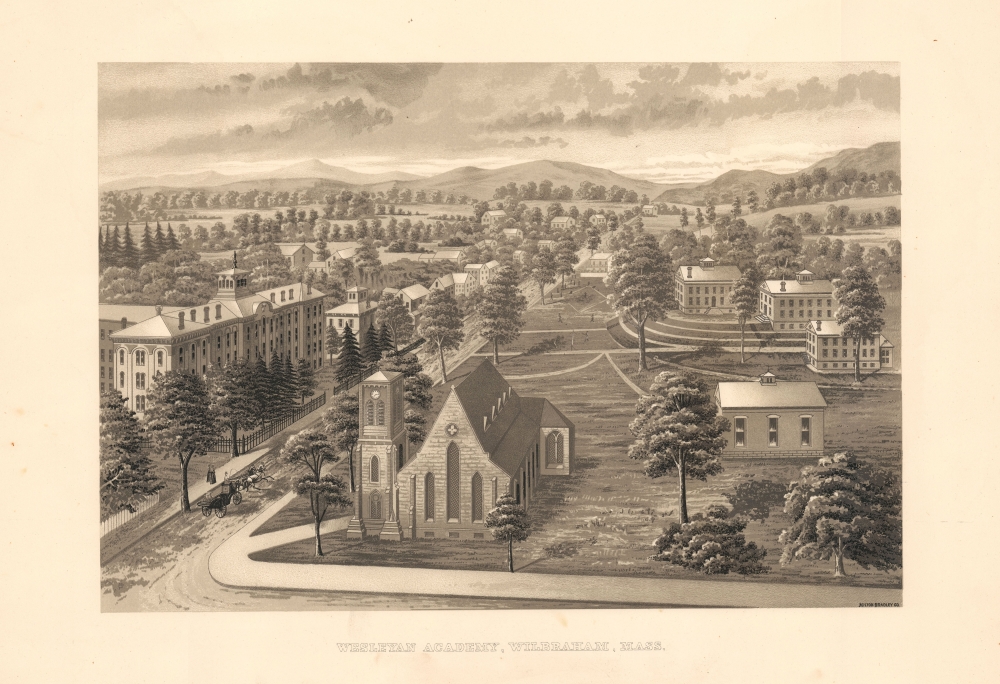1890 Milton Bradley View of Wilbraham, Massachusetts
WesleyanAcademy-miltonbradley-1890
Title
1890 (undated) 12 x 16 in (30.48 x 40.64 cm)
Description
A Closer Look
The view is oriented towards the north, depicting today's Academy Historic District, which primarily consists of the historic campuses of Wesleyan Academy and neighboring Monson Academy. The large building on the left is Rich Hall, built in 1861 along Main St., which remains the school's academic and administrative center. In the foreground is the Alumni Memorial Chapel, built in 1867. The group of buildings at right includes the Old Academy (built 1825) and Fisk Hall (1851), the oldest surviving campus buildings. (The oldest building in the entire historic district, the Old Meeting House, is just out of view here, across the street from the Alumni Memorial Chapel). In the background is the town of Wilbraham, behind which lie rolling hills, with the tallest perhaps meant to be Mt. Holyoke and Mt. Tom. In addition to buildings and topography, a group of students can be seen playing sports, including baseball, on athletic fields near center.Wilbraham and Monson Academy
Wilbraham and Monson Academy was founded in 1804 as the Monson Academy. In 1825, the New Hampshire-based Wesleyan Academy, the first coeducational boarding school in the United States (though it later became a boys-only school), moved to Wilbraham, Massachusetts, but continued to operate as a separate school, changing its name to Wilbraham Academy in 1912. In 1971, amid a spate of prep school mergers, the Wilbraham and Monson Academies merged into the single school that exists today, becoming coeducational in the process.Both the formerly separate and now unified academies boast prominent alums, including: Lucy Stone (1818 - 1893), the first woman in Massachusetts to earn a college degree; the inventor, patent lawyer, and cofounder of Scientific American Alfred Ely Beach (1826 - 1896); oil tycoon Charles Pratt (1830 - 1891); U.S. Supreme Court justices William Strong (1808 - 1895) and Henry Billings Brown (1836 - 1913); and Massachusetts governor and U.S. Senator Winthrop Crane (1853 - 1920). Monson Academy was the first American school to admit Chinese students, in 1847, and among them was Yung Wing (容閎, 1828 - 1912), who then graduated from Yale University, being the first known Chinese-born college graduate in the U.S. and an important intermediary between the two countries in the following decades. Yung Wing's classmate at Monson, Wong Fun (黄寬, 1829 - 1878), went on to study medicine at the University of Edinburgh in Scotland, becoming the first Chinese to receive a Western medical degree. The Wesleyan Academy maintained a similarly close relationship with Thailand in the 20th century, counting among its graduates Pote Sarasin (พจน์ สารสิน, 1905 - 2000), who served as foreign minister and prime minister of Thailand, and Nitya Phibunsongkhram (นิตย์ พิบูลสงคราม; 1941-2014), the son of Plaek Phibunsongkhram (Thailand's leader for most of the 1940s and 1950s), who was Thailand's Ambassador to the United States and also a foreign minister. Prominent individuals have also taught at the schools, including Frances Perkins (1880 - 1965), Franklin D. Roosevelt's Secretary of Labor and the first woman to hold a cabinet-level position in the U.S. government.
Publication History and Census
This view was prepared by an unnamed artist and printed by Milton Bradley Co., based in nearby Springfield, which began as a lithographic printer before shifting to producing games, jigsaw puzzles, and toys. It is undated; the production method (a two-tone chromolithograph) and details in the view lead us to estimate a date of 1890, but the company's history suggest sa somewhat earlier date. In any event, it is very rare, with the only other known example being held by the Boston Athenaeum, which dates it to 'after 1884'.Cartographer
Milton Bradley (November 8, 1836 - May 30, 1911) was an American game pioneer, publisher, and business magnate, credited with launching the board game industry. Born in Vienna, Maine, Bradley grew up in a working-class family and worked as a draftsman and patent agent after finishing high school. He was unable to finish his studies at the Lawrence Scientific School in Cambridge, Massachusetts after he and his family moved to Hartford, Connecticut, where he was unable to find a job. Bradley moved to Springfield, Massachusetts, in 1856, where he found work as a mechanical draftsman. He went to Providence, Rhode Island, to learn lithography in 1859 and returned to Springfield in 1860 and set up the city's first color lithography shop. His first game, inspired by a foreign game gifted to him by a friend, released in the winter of 1860, was called The Checkered Game of Life, an early version of The Game of Life. His game proved to be an instant success. Bradley personally sold the entire first run of several hundred copies during a two-day visit to New York City. Over 45,000 had sold by 1861. Bradley founded the Milton Bradley Company in 1860, which went on to create many classic American games, including Battleship, Candy Land, and Operation. Bradley married Vilona Eaton in 1860, who died in 1867. Bradley then remarried in 1869 to Ellen Thayer, and he and Ellen had two daughters. More by this mapmaker...

